Transverse Deflection for Extreme Ultraviolet Pellicles
Abstract
1. Introduction
2. Simulation Methods
2.1. Mechanical Deformation
2.2. Analytical-Numerical Method
2.3. Finite Element Method (FEM)
2.4. Deep Learning
2.5. Response Surface Methodology
3. Results and Discussion
3.1. Plate Clamped at Contour
- Minimum mesh size of more than 100 μm size;
- Meshing of more than 10 μm thickness. A structure of - did not mesh;
- Design of more than 10- scale;
- Solving of less than 20,000 mash nodes.
3.2. Results of Deep Learning
3.3. Anaysis
4. Conclusions
Funding
Institutional Review Board Statement
Informed Consent Statement
Data Availability Statement
Conflicts of Interest
References
- Wu, B.; Kumar, A. Extreme Ultraviolet Lithography and Three Dimensional Integrated Circuit-A Review. Appl. Phys. Rev. 2014, 1, 011104. [Google Scholar] [CrossRef]
- Miyazaki, J.; Yen, A. EUV Lithography Technology for High-Volume Production of Semiconductor Devices. J. Photopolym. Sci. Technol. 2019, 32, 195–201. [Google Scholar] [CrossRef]
- Jonckheere, R. EUV Mask Defectivity—A Process of Increasing Control toward HVM. Adv. Opt. Techn. 2017, 6, 203–220. [Google Scholar] [CrossRef]
- Hector, S.; Mangat, P. Review of Progress in Extreme Ultraviolet Lithography Masks. J. Vac. Sci. Technol. B 2001, 19, 2612–2616. [Google Scholar] [CrossRef]
- Brouns, D. Development and performance of EUV pellicles. Adv. Opt. Techn. 2017, 6, 221–227. [Google Scholar] [CrossRef]
- Lin, B.J. Making Lithography Work for the 7-nm Node and Beyond in Overlay Accuracy, Resolution, Defect, and Cost. Microelectron. Eng. 2015, 143, 91–101. [Google Scholar] [CrossRef]
- Kwon, D.-H.; Kang, H.-G.; Kim, T.-G.; Ahn, J.-H.; Lee, S.-S.; Park, J.-G. Removal Behavior of Sn and Pb Contaminants on EUV Mask after EUV Exposure. In Proceedings of the SPIE Photomask Technology, Monterey, CA, USA, 25–29 September 2022; p. 122930B. [Google Scholar]
- Zoldesi, C.; Bal, K.; Blum, B.; Bock, G.; Brouns, D.; Dhalluin, F.; Dziomkina, N.; Espinoza, J.D.A.; de Hoogh, J.; Houweling, S.; et al. Progress on EUV Pellicle. In Proceedings of the SPIE Advanced Lithography, San Jose, CA, USA, 23–27 February 2014; p. 90481N. [Google Scholar]
- Shroff, Y.A.; Leeson, M.; Yan, P.-Y.; Gullikson, E.; Salmassi, F. High Transmission Pellicles for Extreme Ultraviolet Lithography Reticle Protection. J. Vac. Sci. Technol. B 2010, 28, C6E36–C6E41. [Google Scholar] [CrossRef]
- Sianipar, M.; Kim, S.H.; Khoiruddin; Iskandar, F.; Wenten, G. Functionalized Carbon Nanotube (CNT) Membrane: Progress and Challenges. RSC Adv. 2017, 7, 51175–51198. [Google Scholar] [CrossRef]
- Timmermans, M.Y.; Mariano, M.; Pollentier, I.; Richard, O.; Huyghebaert, C.; Gallagher, E.E. Free-standing Carbon Nanotube Films for Extreme Ultraviolet Pellicle Application. J. Micro/Nanolith. MEMS MOEMS 2018, 17, 043504. [Google Scholar] [CrossRef]
- Kim, S.-G.; Shin, D.-W.; Kim, T.; Kim, S.; Lee, J.H.; Lee, C.G.; Yang, C.-W.; Lee, S.; Cho, S.J.; Jeon, H.C.; et al. Large-Scale Freestanding Nanometer-Thick Graphite Pellicles for Mass Production of Nanodevices Beyond 10-nm. Nanoscale 2015, 7, 14608–14611. [Google Scholar] [CrossRef]
- Choi, H.-W.; Nam, K.-B.; Shin, D.-W. Graphite Pellicle: Physical Shield for Next-Generation EUV Lithography Technology. Adv. Mater. Interfaces 2023, 10, 2202489. [Google Scholar] [CrossRef]
- Pollentier, I.; Lee, J.U.; Timmermans, M.; Adelmann, C.; Zahedmanesh, H.; Huyghebaert, C.; Gallagher, E.E. Novel Membrane Solutions for the EUV Pellicle: Better or Not? In Proceedings of the SPIE Advanced Lithography, San Jose, CA, USA, 26 February–2 March 2017; p. 101430L. [Google Scholar]
- Wi, S.J.; Jang, Y.J.; Lee, D.G.; Kim, S.Y.; Ahn, J. Investigating the Degradation of EUV Transmittance of an EUV Pellicle Membrane. Membranes 2023, 13, 5. [Google Scholar] [CrossRef] [PubMed]
- Evanschitzky, P.; Erdmann, A. Efficient Simulation of EUV Pellicles. In Proceedings of the SPIE Photomask Technology and EUV Lithography, Montery, CA, USA, 11–14 September 2017; p. 104500. [Google Scholar]
- Chen, Y.; Zhou, X.; Klosternann, U.; Sun, L.; Wood II, O.; Braylovska, M.; Marokkey, S.; Goodwin, F. Rigorous Simulation of EUV Mask Pellicle. In Proceedings of the SPIE Photomask Technology and EUV Lithography, Montery, CA, USA, 11–14 September 2017; p. 104500. [Google Scholar]
- Melvin III, L.; Jonckheere, R. Contribution of Mask Defectivity in Stochastics of EUVL-Based Wafer Printing. J. Micro/Nanopattern. Mater. Metrol. 2021, 20, 021003. [Google Scholar] [CrossRef]
- Devaraj, L.; Bottiglieri, G.; Erdmann, A.; Wahlisch, F.; Kupers, M.; van Setten, E.; Fliervoet, T. Lithographic Effects due to Particles on High NA EUV Mask Pellicle. In Proceedings of the SPIE 35th European Mask and Lithography Conference, Dresden, Germany, 17–19 June 2019; p. 111770. [Google Scholar]
- Hsueh, C.-H. Modeling of Elastic Deformation of Multilayers Due to Residual Stresses and External Bending. J. Appl. Phys. 2002, 91, 9652–9656. [Google Scholar] [CrossRef]
- Ban, C.-H.; Kang, I.-H.; Choi, W.-Y.; Oh, H.-K. Reduced Lifetime of EUV Pellicles Due to Defects. J. Micro/Nanolith. MEMS MOEMS 2021, 20, 034401. [Google Scholar] [CrossRef]
- Kim, J.; Kim, H.; Ahn, J. Impact of Residual Stress on the Deflection of Extreme Ultraviolet Pellicles. J. Micro/Nanolith. MEMS MOEMS 2021, 20, 024401. [Google Scholar] [CrossRef]
- Wang, H.; Rashke, R.; Newman, C.; Harris, A. An Update on Pellicle-Compatible EUV Inner Pod Development. In Proceedings of the SPIE Advanced Lithography, San Jose, CA, USA, 21–25 February 2016; p. 97762Q. [Google Scholar]
- Hakim, G.; Abramovich, H. Large Deflections of Thin-Walled Plates under Transverse Loading—Investigation of the Generated In-Plane Stresses. Materials 2022, 15, 1577. [Google Scholar] [CrossRef] [PubMed]
- Timoshenko, S.; Woinowsky-Krieger, S. Rectangular Plates with All Edges Built-In. In Theory of Plates and Shells, 2nd ed.; McGraw-Hill: New York, NY, USA, 1959; pp. 197–202. [Google Scholar]
- Nwoji, C.; Mama, B.; Ike, C.; Onah, H. Galerkin-Vlasov Method for the Flexural Analysis of Rectangular Kirchhoff Plates with Clamped and Simply Supported Edges. Iosr J. Mech. Civ. Eng. 2017, 14, 61–74. [Google Scholar]
- Ventsel, E.; Krauthammer, T. Navies’s Method (Double Series Solution). In Thin Plates and Shells: Theory, Analysis, and Applications; Marcel Dekker: New York, NY, USA, 2001; pp. 54–60. [Google Scholar]
- Mantari, J.L.; Oktem, A.S.; Guedes Soares, C. A New Trigonometric Shear Deformation Theory for Isotropic, Laminated Composite and Sandwich Plates. Int. J. Solids Struct. 2012, 49, 43–53. [Google Scholar] [CrossRef]
- Khlifi, K.; Casimir, J.B.; Akrout, A.; Haddar, M. Dynamic Stiffness Method: New Levy’s Series for Orthotropic Plate Elements with Natural Boundary Conditions. Eng. Struct. 2021, 245, 112936. [Google Scholar] [CrossRef]
- Buczkowski, R.; Torbacki, W. Finite Element Modelling of Thick Plates on Two-Parameter Elastic Foundation. Int. J. Numer. Anal. Meth. Geomech. 2001, 25, 1409–1427. [Google Scholar] [CrossRef]
- Xing, Y.; Liu, B. High-Accuracy Differential Quadrature Finite Element Method and its Application to Free Vibrations of Thin Plate with Curvilinear Domain. Int. J. Numer. Methods Eng. 2009, 80, 1718–1742. [Google Scholar] [CrossRef]
- Aimakov, N.; Tanner, G.; Chronopoulos, D. A Wave Finite Element Approach for Modelling Wave Transmission through Laminated Plate Junctions. Sci. Rep. 2022, 12, 1852. [Google Scholar] [CrossRef] [PubMed]
- Guminiak, M. Static and Free Vibration Analysis of Thin Plates of the Curved Edges by the Boundary Element Method Considering an Alternative Formulation of Boundary Conditions. Engng. Trans. 2016, 64, 3–32. [Google Scholar]
- Kim, D.J.; Duarte, C.A.; Pereira, J.P. Analysis of Interacting Cracks Using the Generalized Finite Element Method with Global-Local Enrichment Functions. J. Appl. Mech. 2008, 75, 051107. [Google Scholar] [CrossRef]
- Malekan, M.; Barros, F.B.; Pitangueira, R.L.S.; Alves, P.D. An Object-Oriented Class Organization for Global-Local Generalized Finite Element Method. Lat. Am. J. Solids Struct. 2016, 13, 2529–2551. [Google Scholar] [CrossRef]
- Delyavskyy, M.; Rosinski, K. The New Approach to Analysis of Thin Isotropic Symmetrical Plates. Appl. Sci. 2020, 10, 5931. [Google Scholar] [CrossRef]
- Stolarshi, T.; Nakasone, Y.; Yoshimoto, S. Fundamentals of the Finite Element Method in Engineering Analysis with ANSYS Software, 2nd ed.; Butterwork-Heinemann: Cambridge, MA, USA, 2018; pp. 1–35. [Google Scholar]
- Altman, N.; Krzywinski, M. Points of Significance: Simple Linear Regression. Nat. Methods 2015, 12, 999–1000. [Google Scholar] [CrossRef]
- Perez-Dominguez, L.; Garg, H.; Luviano-Cruz, D.; Alcaraz, J.L.G. Estimation of Linear Regression with the Dimensional Analysis Method. Mathematics 2022, 10, 1645. [Google Scholar] [CrossRef]
- Krzywinski, M.; Altman, N. Multiple Linear Regression. Nat. Methods 2015, 12, 1103–1104. [Google Scholar] [CrossRef]
- Li, T.-S.; Chen, S.-H.; Chen, H.-L. Thermal-Flow Techniques for Sub-35 nm Contact-Hole Fabrication using Taguchi Method in Electron-Beam Lithography. Microelectron. Eng. 2009, 86, 2170–2175. [Google Scholar] [CrossRef]
- Macias, H.A.; Yate, L.; Coy, E.; Aperador, W.; Olaya, J.J. Insights and Optimization of the Structural and Mechanical Properties of TiWSiN Coatings using the Taguchi method. Appl. Surf. Sci. 2021, 558, 149877. [Google Scholar] [CrossRef]
- Alzbaidi, L.; Zhang, J.; Humaidi, A.J.; Al-Dujaili, A.; Duan, Y.; Al-Shamma, O.; Santamaria, J.; Fadhel, M.A.; Al-Amidie, M.; Farhan, L. Review of Deep Learning: Concepts, CNN Architectures, Challenges, Applications, Future Directions. J. Big Data 2021, 53, 53. [Google Scholar] [CrossRef] [PubMed]
- Pang, B.; Nijkamp, E.; Wu, Y.N. Deep Learning with TensorFlow: A Review. J. Educ. Behav. Stat. 2020, 45, 227–248. [Google Scholar] [CrossRef]
- Novac, O.-C.; Chirodea, M.C.; Novac, C.M.; Bizon, N.; Oproescu, M.; Stan, O.P.; Gordan, C.E. Analysis of the Application Efficiency of TensorFlow and PyTorch in Convolutional Neural Network. Sensors 2022, 22, 8872. [Google Scholar] [CrossRef]
- Hao, J.; Ho, T.K. Machine Learning Made Easy: A Review of Scikit-learn Package in Python Programming Language. J. Educ. Behav. Stat. 2019, 44, 348–361. [Google Scholar] [CrossRef]
- Huff, M. Review Paper: Residual Stresses in Deposited Thin-Film Material Layers for Micro- and Nano-Systems Manufacturing. Micromachines 2022, 13, 2084. [Google Scholar] [CrossRef]
- Senjanovic, I.; Vladimir, N.; Croatia, Z.; Cho, D.S. A Shear Locking-Free-Beam Finite Element Based on the Modified Timoshenko Bean Theory. Trans. FAMENA 2013, 37, 1–16. [Google Scholar]
- Baier-Saip, J.A.; Baier, P.A.; de Faria, A.R.; Oliveira, J.C.; Baier, H. Shear Locking in One-Dimensional Finite Element Methods. Eur. J. Mech. A Solids 2020, 79, 103871. [Google Scholar] [CrossRef]
- Huang, Y.W.; Chiang, K.N. Study of Shear Locking Effect on 3D Solder Joint Reliability Analysis. J. Mech. 2022, 38, 176–184. [Google Scholar] [CrossRef]
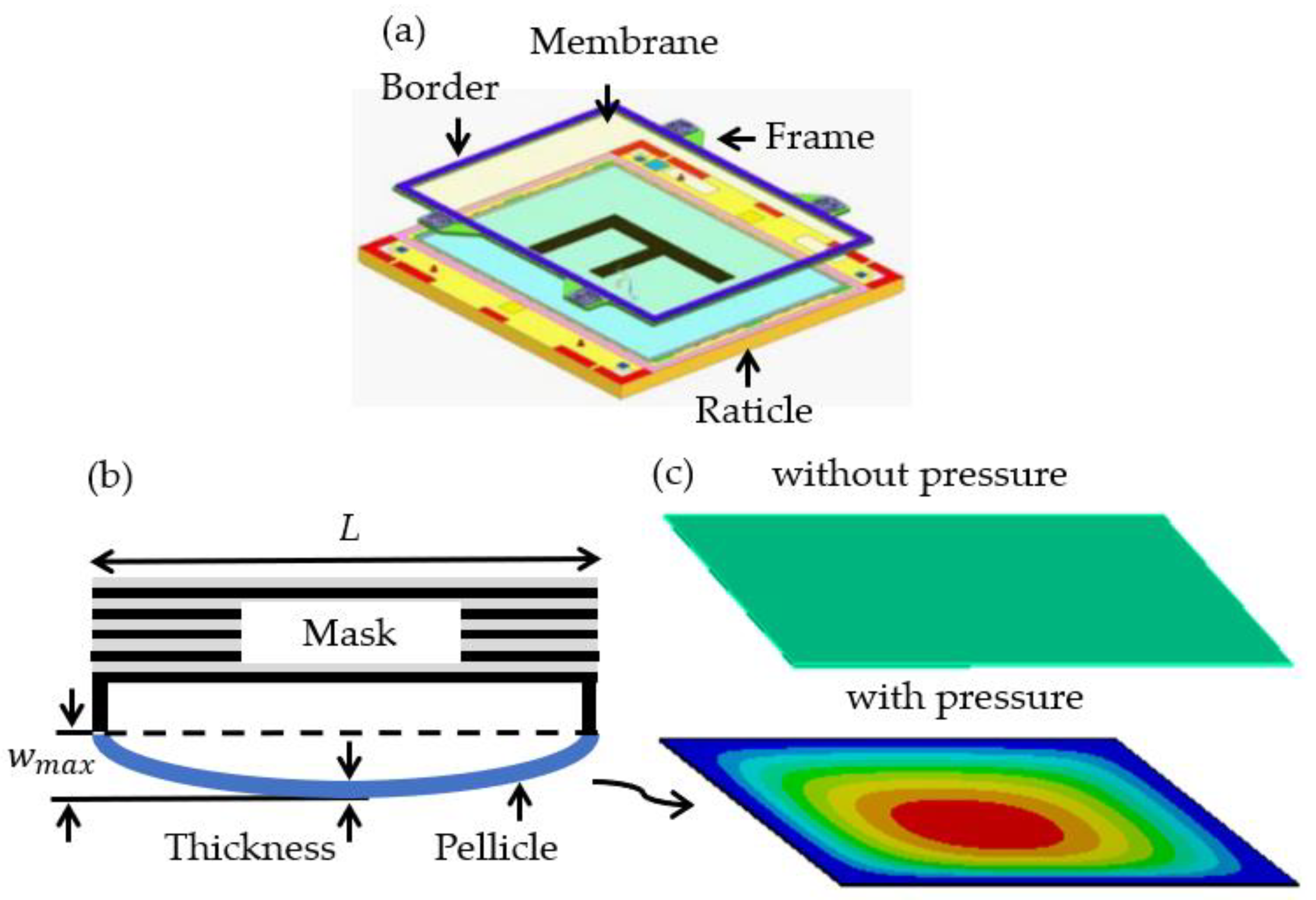
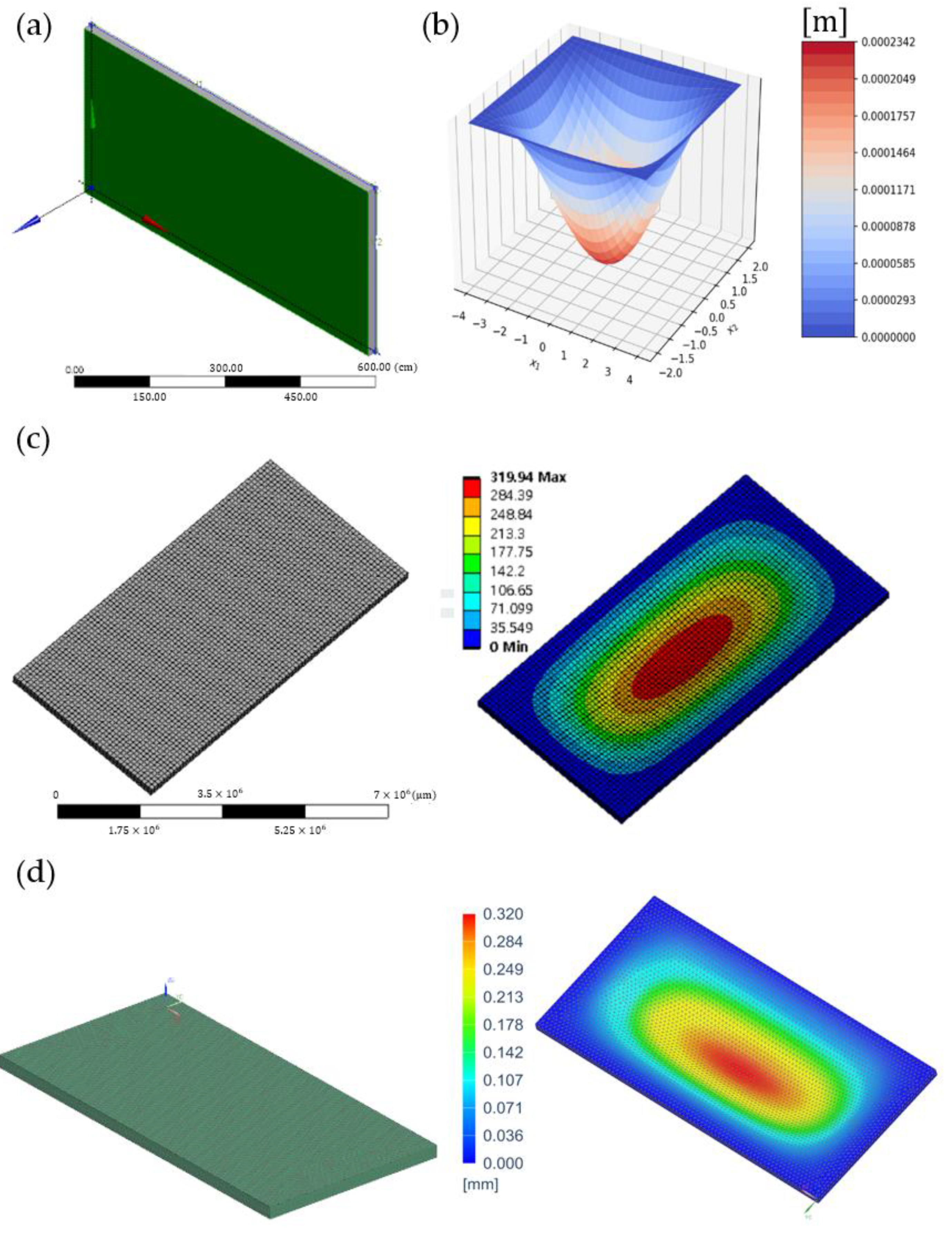
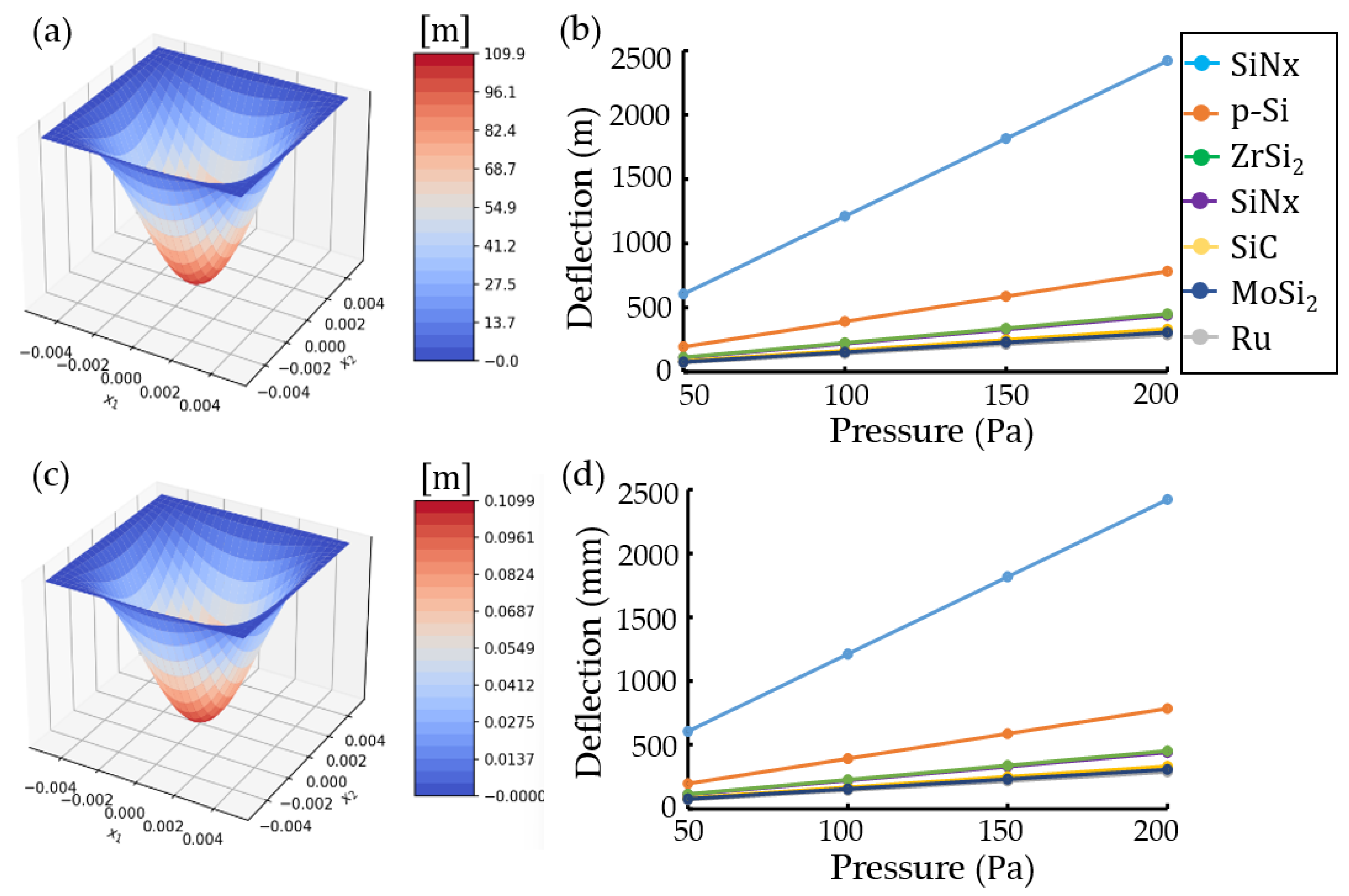
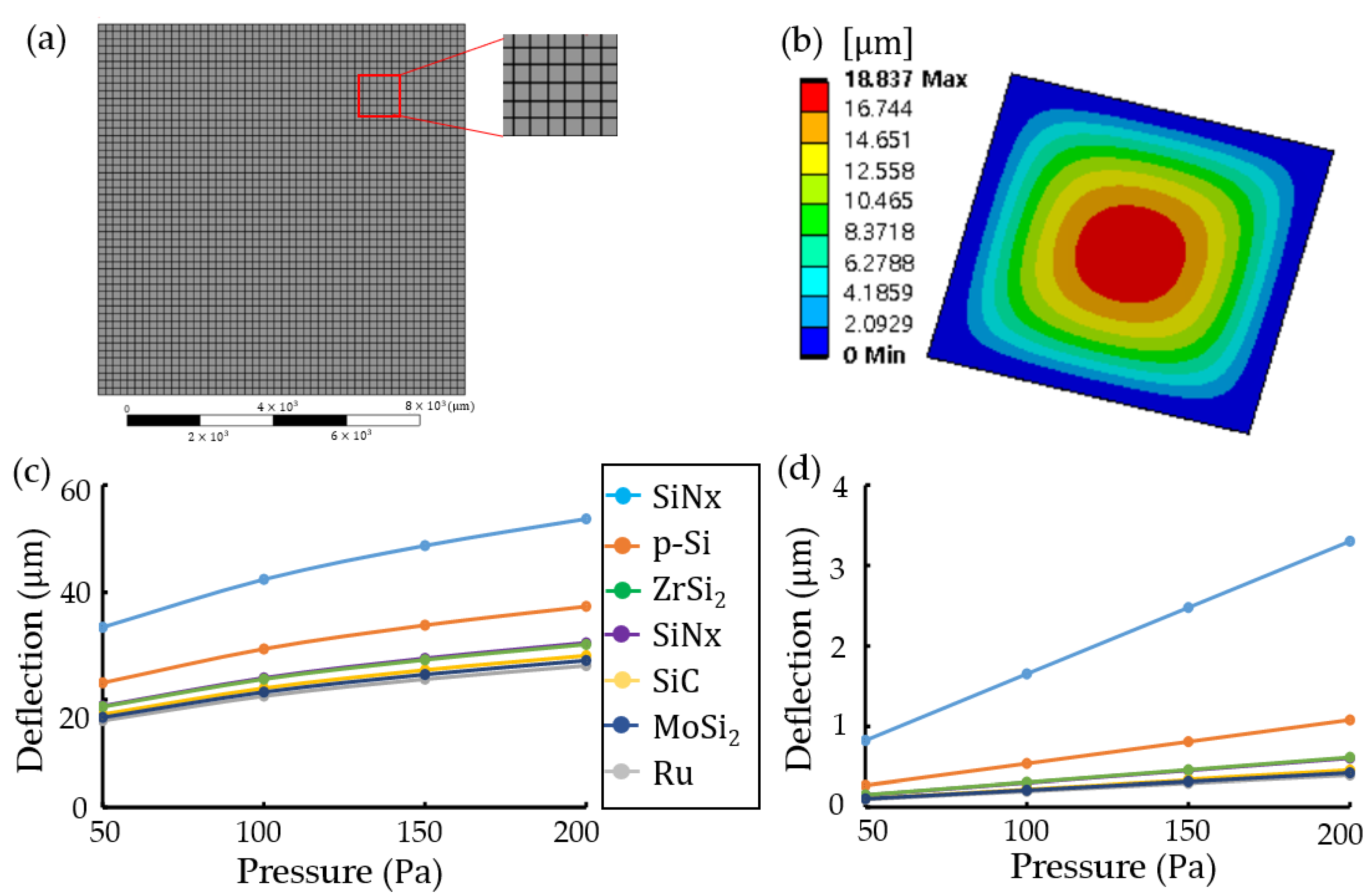
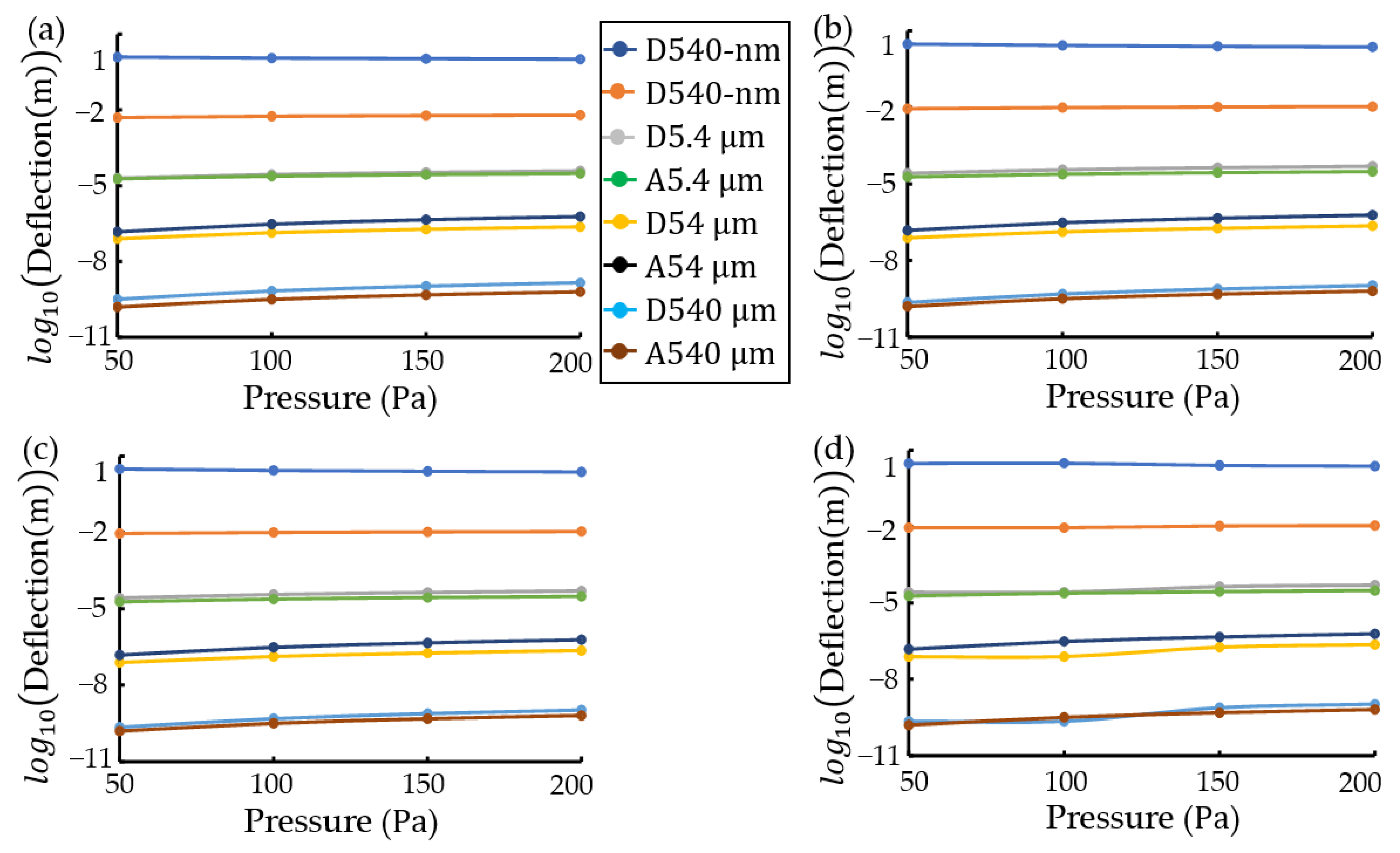

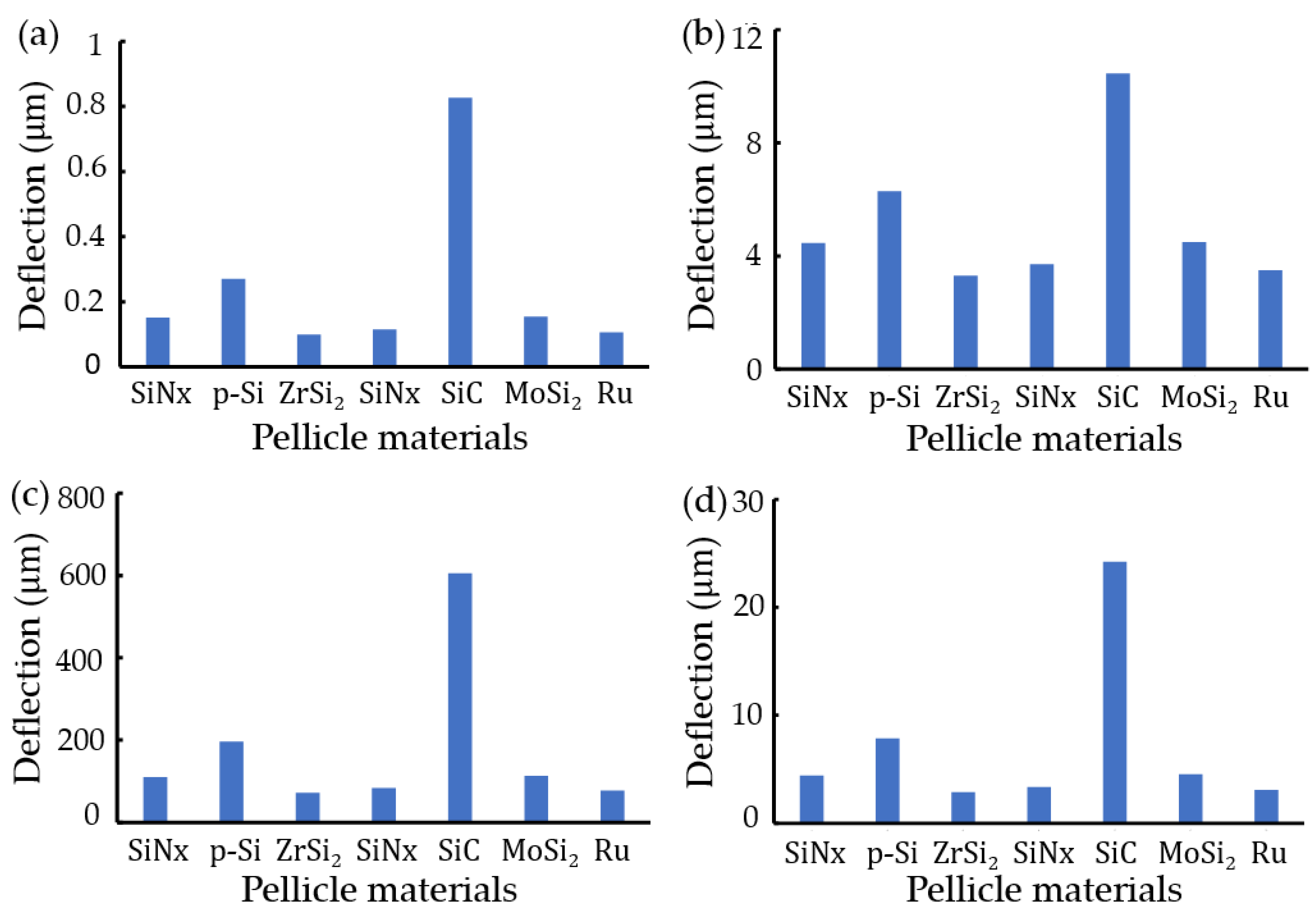
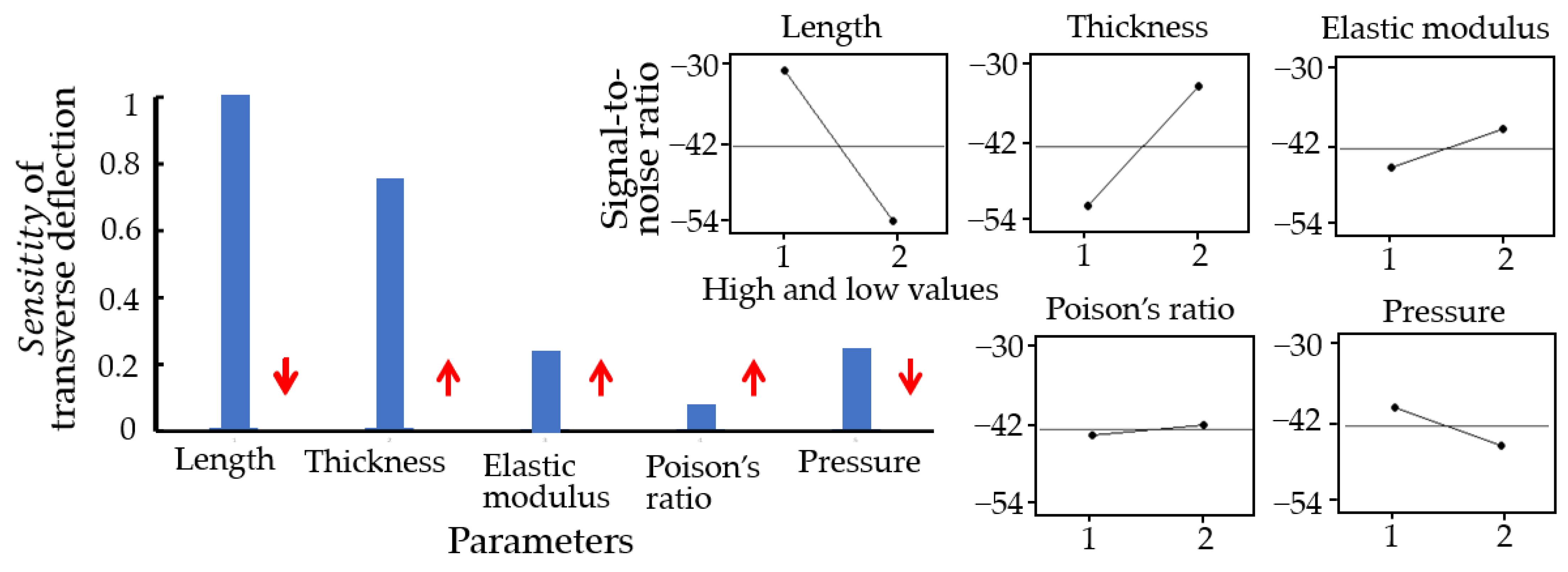
| Deflection | ||
|---|---|---|
| Unit: m | Min | Max |
| Python program | 0.0 | 0.0002343 |
| ANSYS | 0.0 | 0.00031428 |
| SIEMENS | 0.0 | 0.00032994 |
| 50 Pa | 100 Pa | 150 Pa | 200 Pa | |
|---|---|---|---|---|
| 54- | 0.099612 | 0.058243 | 0.032225 | 0.013248 |
| 540- | −2.298013 | −2.241721 | −2.218677 | −2.198874 |
| 50 Pa | 100 Pa | 150 Pa | 200 Pa | |
|---|---|---|---|---|
| Exp. 1 | −4.29243 | −4.110698 | −4.010995 | −3.948847 |
| Python | −4.293415 | −4.111958 | −4.012543 | −3.94681 |
| Scikit | −4.292584 | −4.110012 | −4.011903 | −3.94847 |
Disclaimer/Publisher’s Note: The statements, opinions and data contained in all publications are solely those of the individual author(s) and contributor(s) and not of MDPI and/or the editor(s). MDPI and/or the editor(s) disclaim responsibility for any injury to people or property resulting from any ideas, methods, instructions or products referred to in the content. |
© 2023 by the author. Licensee MDPI, Basel, Switzerland. This article is an open access article distributed under the terms and conditions of the Creative Commons Attribution (CC BY) license (https://creativecommons.org/licenses/by/4.0/).
Share and Cite
Kim, S.-K. Transverse Deflection for Extreme Ultraviolet Pellicles. Materials 2023, 16, 3471. https://doi.org/10.3390/ma16093471
Kim S-K. Transverse Deflection for Extreme Ultraviolet Pellicles. Materials. 2023; 16(9):3471. https://doi.org/10.3390/ma16093471
Chicago/Turabian StyleKim, Sang-Kon. 2023. "Transverse Deflection for Extreme Ultraviolet Pellicles" Materials 16, no. 9: 3471. https://doi.org/10.3390/ma16093471
APA StyleKim, S.-K. (2023). Transverse Deflection for Extreme Ultraviolet Pellicles. Materials, 16(9), 3471. https://doi.org/10.3390/ma16093471







